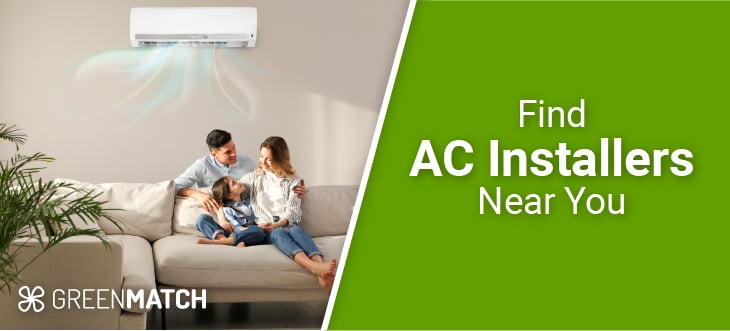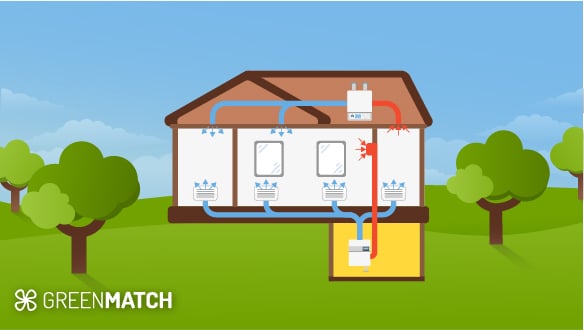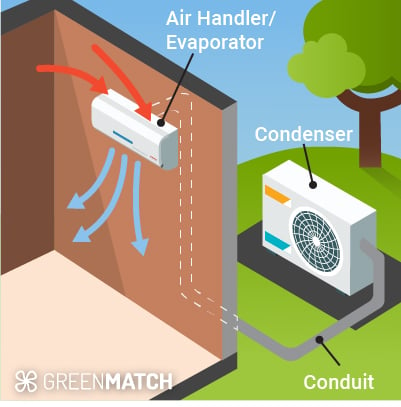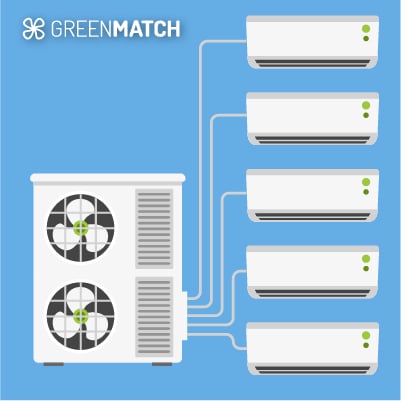You will be redirected to a Leads.io registration page.

You need to fill in only 1 form to get free quotes

We call you to confirm your enquiry

Receive quotes from local installers
- GreenMatch.com
- HVAC
- Air Conditioning
Air Conditioning Systems for Homes
What is the right system for you?

About three-quarters of the homes in the US use an air conditioning system. Air conditioners (AC) are generally part of your HVAC (Heating, Ventilation, and Air Conditioning) system. However, not all homes would have a full-blown HVAC system. In that case, you have several options to choose from if looking to add an air conditioning system to your home.
An air conditioning system basically works like your refrigerator. It transfers heat from the inside of your home to the exterior using energy. It is a system that is used to control and regulate the inside temperature of your home, humidity and also the indoor air quality. Most air conditioners today also work as a heater. The main components of an air conditioning system are:
Thermostat: It allows you to control the air conditioning system by setting the desired temperature, and also activating or deactivating the system as per your needs.
Indoor unit: This is the part of the air conditioning system that is installed inside your home. This is the unit that typically cools, or heats in some cases, your home.
Outdoor unit: The outdoor unit is the part of the system that plays the crucial role of expelling heat from the indoor space to the outside environment, or vice versa in some cases.
Refrigerant: A refrigerant is a specialized fluid that circulates between the indoor and outdoor units through a tube connecting the two. The fluid absorbs heat from inside your home and releases it outside. Hydrochlorofluorocarbons (HCFCs) and hydrofluorocarbons (HFCs) are the most commonly used refrigerants.
Air conditioning systems, whether part of an HVAC system or individual systems, need to be chosen carefully. Several factors need to be considered when deciding on installing a system. Companies and installers are often a huge help in helping you identify your needs and what system would work best for your home. However, finding the right installer is also just as much a daunting task.
You will be spending hours of your time, calling one installer after the other, explaining your requirements and requesting quotes. Then you’ll sit and compare each of them, sifting through trying to find the best fit. Or you can simply click on the button below, fill in the form and tell us your requirements. We will find up to three certified installers who best fit your requirements and have their quotes for you to compare. GreenMatch offers free service with no obligation.
Fill in the form in just 1 minute
How Does An Air Conditioning System Work?
An air conditioning system, as mentioned above, works just like your refrigerator does. It involves the same basic working principle of a refrigeration cycle. We have discussed below the working of an air conditioning system in detail:
Thermostat: A thermostat is a controlling unit that allows you to set a desired temperature. It allows you to
increase or decrease the temperature as per your need. When the thermostat senses an increase in the temperature it signals the air conditioning components to start running.
Evaporation: The process starts with the fan in the indoor unit pulling in the warm air from inside the room through the return ducts. The warm air then passes over the cold evaporator coil with the refrigerant inside. As the low-pressured liquid refrigerant comes in contact with the warm air, it evaporates into a gaseous state. As the gas passes over the cooling coil, the air turns cold. The blower fan in the indoor unit then blows out the chilled air into the room.
Compression: In order to keep cooling your home efficiently, the refrigerant gas needs to be converted back into liquid. This task is handled by the compressor, which compresses the gas placing it under high pressure, creating extra, unwanted heat.
Condensation: This unwanted heat is then released into the outside air through a second set of coils (condenser coils) and a fan. As the unwanted heat is released, the refrigerant gas undergoes condensation and turns back to a high-pressurised liquid state.
Expansion: This condensed, high-pressure liquid refrigerant passes through an expansion valve, which reduces its pressure. As a result, the low-pressure liquid refrigerant is once again ready to enter the evaporator coil.
Repetition: The cycle repeats itself until the desired temperature is achieved in the room or home.
In addition to cooling, air conditioning systems also filter the air and control humidity. When the warm air is pulled in, it passes through a filter that removes any particles from the air. It then passes over the evaporator coil, where the moisture in the air condenses and is thrown out, reducing the humidity level in the room.
Modern air conditioning systems often come with programmable thermostats with multiple speed settings, and zoning options, which also enhances the system’s energy efficiency.
Types of Air Conditioning Systems for Homes
Various types of air conditioning systems are commonly used in homes across the US for cooling and comfort. According to the most recent survey conducted by the U.S. Energy Information Administration in 2020, 88% of the homes used air conditioning systems. Of these, 66% of homes have central air conditioning while the remaining 22% use other types of air conditioning systems.
Other than central air conditioning, there are split air conditioners, portable air conditioners, ductless mini-split air conditioners, and window air conditioners. These five, along with central air conditioning systems are most commonly used in homes. Below we have discussed each of these briefly to give you an overview and help understand which system would best fit your home and your requirements.
Central Air Conditioning

Central air conditioning, a part of an HVAC system, is ideal for cooling larger homes or for cooling multiple rooms at the same time. The centralized system distributes cool air through a network of ducts and vents. The system, as explained above, includes an indoor unit with an evaporator coil and a blower fan for cooling the indoors and an outdoor unit with a condenser and compressor for removing heat. You can control these systems through the thermostat and set the desired temperatures for consistent cooling.
Split System Air Conditioners

Split systems are similar to central air conditioning systems, except that they don't require a complex network of ductwork and vents. These systems also come with an indoor unit (with an evaporator coil and a blower fan) and an outdoor unit (with a condenser and a compressor), which are connected with ducts. Split systems are ideal if your home does not have an existing HVAC system or for cooling particular zones or rooms in your home. or for specific zones in larger homes. The two major benefits of split AC are that they offer flexibility in installation and zoning.
Ductless Mini-Split Air Conditioners

Ductless mini-split systems are a type of split system, with a single exception of these systems having multiple indoor units that are connected to a single outdoor unit. This system is ideal if you are adding rooms to your home or if there are zones or areas in your home that require individual cooling. Just like split air conditioners, the ductless mini-splits are also mounted on a wall or ceiling of the room. Each of the indoor units is connected to the outdoor unit with ducts.
Window Air Conditioners

Window air conditioners are ideal for individual or smaller rooms. These are self-contained air conditioning systems, in that it houses all the components of an air conditioning system – evaporator, condenser, compressor, and fans in a single boxed unit. These are typically installed in a window with part of the unit on the exterior of your room. The air conditioner blows cooled air into the room and expels heat and humidity outside. The thermostat is included in the boxed unit as well, allowing you to have control over the temperature of the room. These AC systems are fairly easy to install and are comparatively inexpensive.
Portable Air Conditioners

Portable air conditioners are air conditioning units that you can move from one room to another based on your cooling requirements. Like window air conditioners, they are self-contained and are equipped with a flexible exhaust hose that is to be vented through a window or wall. It works just like every other air conditioning system, pulling in warm air, blowing it out into the room after cooling it, and ventilating the heat outside through the hose. Although they offer versatility in terms of placement and are easy to use, they are comparatively less effective than other air conditioning systems. Portable air conditioners are ideal for very small spaces or for temporary use.
Finding the right air conditioner for your home is as daunting a task as finding the right installer. GreenMatch can make this task simpler for you. Simply click on the button below and we will match up to three certified installers that best fit your requirements and get their quotes for you to compare.
Fill in the form in just 1 minute
What Factors to Consider When Choosing an Air Conditioning System?
Choosing the right air conditioning system is a very important step. If not, it may turn out to be a waste of your hard-earned money and your need for cooling would go overlooked. There are several factors that need to be considered when choosing an air conditioning system for your home.
The most important factor to consider is whether the air conditioning system you are considering fits within your budget or not. There are two sides to the cost of an AC system – upfront equipment costs and long-term maintenance costs. If you decide to go for a high-end energy efficient AC, the upfront cost may be high, but it may minimize your long-term maintenance costs.
The size of the room or your home plays a crucial role in the selection of an air conditioning system. If you choose an AC system that is small while your room is larger in size, it will greatly decrease the energy efficiency of the system. It would also be unable to cool the room to satisfactory levels, rendering it an inept investment.
Energy efficiency of the air conditioning system you choose is another important factor to consider. Choosing an energy efficient system will greatly minimize energy consumption, in turn reducing your utility bills. For better energy efficiency, consider buying AC systems that have a high SEER (Seasonal Energy Efficiency Ratio) rating.
Many air conditioning systems are noisy. In order to minimize the noise levels inside your home, look for quieter systems. Manufacturers of air conditioners provide information on noise levels in the information sheet.
Find the Best Quotes for Air Conditioning System Installation

Comparing quotes from different vendors and installers is always in your benefit. It helps you understand the differences in cost, features, and services offered by each installer. If you go for a local installer, their service may prove easy on your pocket, while a national or global manufacturer may charge more.
Finding the right installer is often a challenge. It requires you to spend hours of your time calling manufacturers and installers one after the other. You will be explaining your requirements, requesting quotes, and then sitting and comparing them.
GreenMatch makes this fairly easy for you. You simply have to click on the button below and fill in the form. We will do the hard work for you, find up to three certified installers that best fit your requirements, and get their quotes for you to compare. Our service is free with no obligation.
Fill in the form in just 1 minute
Frequently Asked Questions
Some of the most common types of AC systems used in the homes across US include central air conditioning systems, split AC systems, ductless mini-split systems, window ACs, and portable air conditioners.
The selection of the type of air conditioning system for your home is dependent on several factors such as your budget, the size of your room or home, the energy efficiency of the system, and noise levels of the system, to name a few.
HVAC systems heat, cool, and ventilate your home, whereas an AC system only cools your home.
We strive to connect our customers with the right product and supplier. Would you like to be part of GreenMatch?

